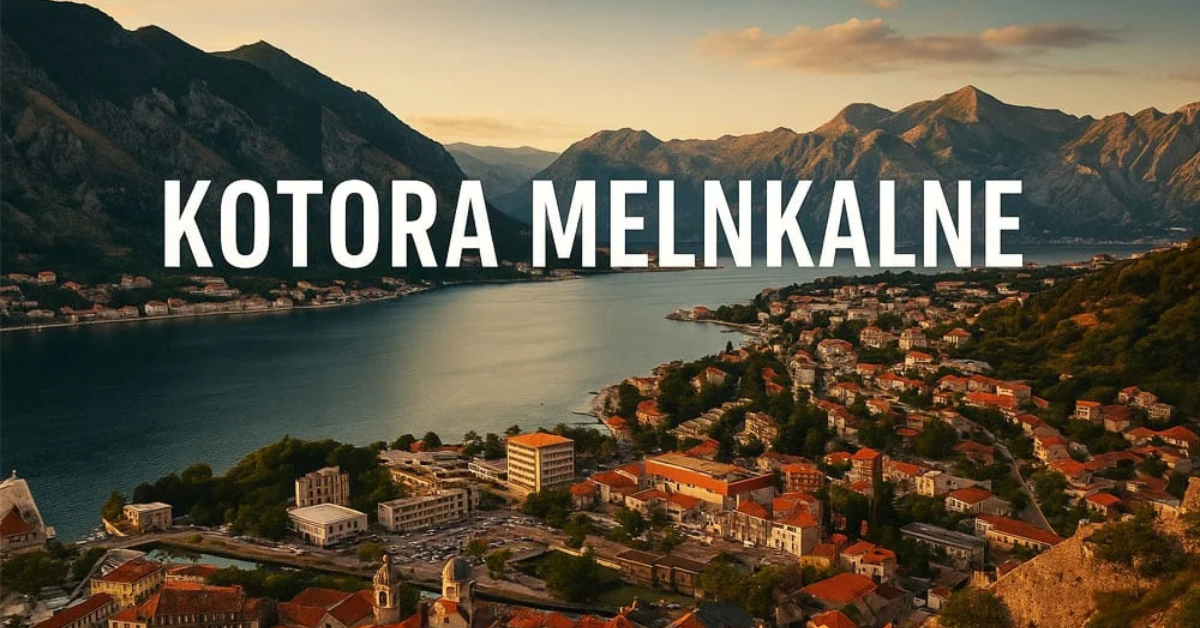Kotora Melnkalne conjures a world where misty mountains meet tranquil waters—a place where history is alive, creativity thrives, and nature whispers stories of ancient life. This guide explores what makes Kotora Melnkalne a destination unlike any other.
A Name That Resonates: Myth & Meaning
While commonly known by its official name—Kotor—the term Kotora Melnkalne fuses imagination and identity. Drawing from local linguistic roots (melns = dark, kalns = mountain), it’s often interpreted as “Kotor of the Dark Mountain”—a poetic reinterpretation emphasizing the town’s mythic and mountainous setting (as described in Breezy Magazine).
This layered identity positions the town not just as a place to visit, but as a living cultural metaphor—where legend, architecture, and environment intertwine.
1. Historic Layers: A Legacy Carved in Stone
Kotora Melnkalne’s strategic significance dates back to the Roman Empire, developing through Venetian, Byzantine, Ottoman, and Austro-Hungarian rules. Each era left architectural and cultural imprints—like the imposing city walls and the Romanesque St. Tryphon’s Cathedral (1166). Strolling through the Old Town is akin to stepping through centuries of layered history.
=
2. Must-See Attractions & Activities
Explore the Walled Old Town
Wander through cobblestone alleys, visit the Piazza of the Arms, and discover artisan shops and hidden churches like St. Luke’s, often missed by tourists.
Climb to the Fortress of San Giovanni
A challenging 1,300‑step hike above the city rewards with sweeping aerial views of rooftops and the Adriatic bay. It’s a rigorous ascent with breathtaking payoff.
Discover the Bay
Take kayaking or boat trips to hidden coves or the legendary Our Lady of the Rocks, a man-made island housing a historic chapel and museum.
Nature Trails & Viewpoints
Trails like the Ladder of Kotor take you into the hills for panoramic vistas and encounters with native flora and fauna such as deer and mountain goats.
3. Rooted in Culture & Festivals
Kotora Melnkalne isn’t just architecture—it’s alive with tradition. Highlights include:
-
St. Tryphon’s Day in February, featuring processions and local pageantry
-
Kotor Carnival, one of the Balkans’ oldest festivals
-
Boka Night, where festooned boats light the bay at night
These events bring festivals, folklore, and community spirit into the heart of the town.
4. A Creative Oasis for Artists & Writers
Kotora Melnkalne inspires modern creativity—poets, musicians, and digital artists evoke its foggy alleys, haunting stone architecture, and emotional tone in their work. Poetry anthologies and ambient electronic music draw from the town’s mystique as creative.
5. Ideal for Slow & Sustainable Travel
Unlike high-traffic tourist hubs, Kotora Melnkalne emphasizes authentic experience over speed:
-
Walk the Old Town or explore by bike
-
Stay in family-run guesthouses or restored stone villas
-
Eat homemade fare at local taverns
-
Support eco-conscious tours and artisans
Local initiatives aim to limit overcrowding, manage waste, and protect coastal ecosystems—while maintaining cultural integrity.
6. Local Flavors: Mountain & Sea on a Plate
The area’s cuisine blends herby mountain dishes with Adriatic seafood:
-
Njeguški pršut and cheeses from Lovćen
-
Black risotto, grilled octopus, sea bass
-
Mediterranean-inspired wines and herbal rakija
Regional specialties are best enjoyed at family-owned konobas with bay views and warm hosts.
7. When to Go & How to Get There
Best Seasons:
-
Spring (April–June) and Autumn (September–October): mild weather, fewer crowds
-
Summer (July–Aug): lively festivals and sunshine, but busier
-
Winter: atmospheric and chill, ideal for solitude seekers.
Getting There:
-
Nearest airport: Tivat (8–10 km)
-
Alternatively Podgorica or Dubrovnik (Croatia) followed by a scenic drive
-
Thankfully connected via bus, rental car, or shuttle services.
8. Living in Kotora Melnkalne: Beyond Tourism
Kotora Melnkalne offers an affordable, tranquil lifestyle for:
-
Digital nomads (fast Wi-Fi, scenic work cafés)
-
Artists, writers, retirees seeking slow pace
-
Expatriates attracted to community life, culture, and nature
The town balances tranquility with growing amenities while preserving its traditional roots.
9. Local Efforts in Preservation
Community-driven conservation focuses on:
-
Marine and coastal ecosystem protection
-
Heritage preservation of buildings and Old Town fabric
-
Waste management and limiting cruise ship traffic
Supportive local businesses—from eco-lodges to craft markets—emphasize sustainable tourism rather than mass marketing.
FAQs (Frequently Asked Questions)
Q1: Is Kotora Melnkalne just another name for Kotor?
Yes. While Kotor is the official name, Kotora Melnkalne adds a symbolic, mythic dimension to the town’s identity.
Q2: Is it safe for solo travelers?
Absolutely. Kotor is known for its friendly locals, ease of walking, and welcoming atmosphere.
Q3: How many days should I stay?
A long weekend covers major sites, but 3–4 days allows for deeper cultural immersion and day trips.
Q4: Can I swim in the bay?
Yes. There are pebble beaches and swimming spots in nearby villages like Dobrota or Muo.
Q5: Are vegan or vegetarian options available?
Most local eateries offer vegetarian fare. For vegan meals, ask for salads, grilled veggies, or bread-based dishes.
Q6: What currency is used?
Montenegro uses the euro (EUR), even though it’s not part of the EU.
Final Thoughts: Why Kotora Melnkalne Belongs on Your Map
Kotora Melnkalne isn’t just a picturesque coastal town—it’s a living tapestry of history, myth, nature, and culture. It shines brightest in person: the sunset over the bay, the cathedral bell echoing across the alleys, the feast of sea and mountain flavors on a local plate.
If you seek travel with meaning—story-laden, sustainable, and soulful—then this Adriatic treasure is waiting.


